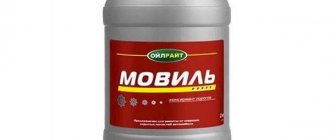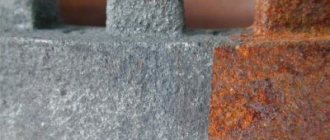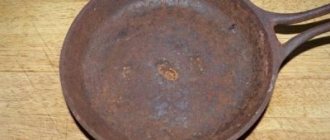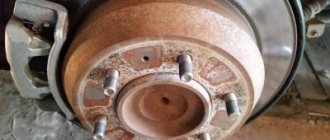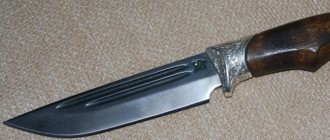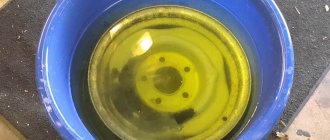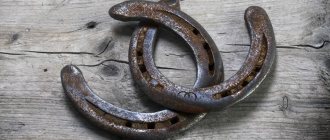What is "Movil"
"Movil" is an anti-corrosion agent that can stop the spread of rust and protect the part from damage. It was created back in the 70s of the last century by scientists from Moscow and Vilnius, during the period when the assembly of the Italian FIAT model began on the basis of the domestic VAZ.
The Italians always treated car body parts with anti-corrosion agents, but the Soviet plant did not have such compounds in its arsenal.
Initially, the product was purchased in Sweden, but VAZ management considered such costs inappropriate, and set the task for its specialists to develop an analogue, but with a cheaper and simpler composition. This is how Movil appeared in the arsenal of the Soviet automobile industry.
The domestic development was made on the same basis as a product from Sweden called Tectyl-390, but the original formula was modified, and very successfully. “Movil” was superior to the original in many respects; it began to be used not only in the USSR, but also in many European countries.
What is Movil needed for?
«Movil
"is an excellent product for protecting hidden cavities (thresholds, door frames, pillars, side members) from corrosion, as well as for temporary protection of the underbody and wheel arches (recommended when the car is being preserved). ...
Interesting materials:
How to see if a person is on Instagram? How to view another person's Saves on Instagram? How can I see who has someone as a friend? How to see in Viber when a person was online? How to forward to a person? How to put a song on a person? How to put a link to a person on Instagram? How to put a link in VK to a person? How to increase a person's blood pressure? How to invite a person to a conversation in VKontakte?
Composition of Movil
"Movil" is a film-forming agent, classified as an inhibitor, based on petroleum products or petroleum-containing products. After applying Movil to a rust-affected area of a body part, penetrant inhibitors penetrate the micropores of iron oxide, transform them into a non-corrosive form, and a durable film of resins is formed on the surface of the area.
This effect is achieved thanks to the thoughtful composition of the product. It includes:
- motor oil and drying oil,
- kerosene and solvent (white spirit),
- inhibitors and zinc,
- rust converters.
Not all formulations include transformative substances. When purchasing Movil, you should give preference to those options that have o or “with converter” on the packaging.
Most people use tannins as a converter - hydrolyzed or condensed substances that can retain and bind other components of the composition. After contact with iron oxide, tannins are converted into water-resistant tannates, which greatly increases the effectiveness of the Movil anti-corrosion agent.
The correct way to apply Movil
Few people go to a service station to have their body treated against corrosion. Because it’s expensive, and you don’t know how they’ll do it. Therefore, it is best to protect the body from rust with your own hands. Properly applied coating lasts for several years.
Expensive special equipment is not required to apply Movil. If you take liquid Movil, then you will need a sprayer (for example, the one used to process potatoes). If there is no sprayer, then it can be applied with a brush. Movil must be diluted with a solvent, for example, White Spirit or No. 646 solution.
In order for the applied anticorrosive to serve for a long time and efficiently, you should wait several days after treating the car body. Don't ride it right away.
Release forms of Movil and leading manufacturers
On the Russian market, this anti-corrosion agent is available in three forms at once - in the form of an aerosol or paste, in liquid form, sold in canisters with a volume of usually 3 liters.
The easiest way to work with Movil is in the form of an aerosol, but it costs much more than its analogues. For a bottle with a volume of 250 to 300 ml you will have to pay from 500 to 700 rubles. You do not need to have special skills or knowledge to treat a rusty area with an aerosol. The only rule is that you need to remove traces of corrosion from the part and always keep the bottle strictly vertical when working.
Liquid Movil, which is sold in cans, costs the least. The container is equipped with a special attachment that makes work easier. 3 liters of the product will cost no more than 450 rubles, depending on the pricing policy of the retail outlet and the starting price in the form of a paste sold in plastic or tin cans with a volume of 850 mg. It will cost from 200 to 300 rubles. In order to work with the paste, you will need to dilute it in the proportions recommended by the manufacturer with a solvent, usually white spirit.
In their reviews of the Movil product, both professionals and car enthusiasts note the products of such domestic companies as Agat-Avto, Astrokhim and Razvitie PKF.
Scope of application of anti-corrosion agent "Movil"
"Movil" is a kind of preservative that prevents contact of metal parts with moisture and other substances that cause corrosion. You can treat any body parts with this product, but you should carefully avoid getting it on plastic and rubber elements. The scope of Movil is quite wide. The product can be applied to
- body elements or their individual sections,
- welding seams after repair,
- arches and hidden cavities in hard-to-reach places,
- side members and door pockets,
- hood and trunk elements,
- "casings" of headlights, floor coverings and other parts.
Experts recommend processing the entire body, even if only one part has been replaced, and spot welding repairs have been performed.
It is strictly not recommended to treat body parts from the inside of the cabin with Movil. The fact is that it has a specific chemical smell that lasts for quite a long time. Those who cannot tolerate such aromas or those who are allergic to substances included in Movil simply will not be able to use the car.
Operating principle
The anti-corrosion or preservative agent "Movil" has a principle of operation based on the most complete sealing and insulation of metals.
This makes it possible to be in close contact with air and moisture, which are the main cause of corrosion on bodies. In addition, thanks to the inhibitor, this composition immediately after application begins to actively fight pockets of corrosion. For car enthusiasts this is a big plus. Treatment with Movil can be carried out without the need to remove bitumen mastic. When the composition is applied to such insulating materials, it tightly covers the surface and passes through the protective layer directly to the metal through various cracks - this is guaranteed insulation of the metal from corrosion. If corrosion processes have already started, then with the help of Movil you can stop the growth of rust.
If you need to park your car for a long time, experts recommend treating the body with this composition as much as possible in all places, so that then, after the expiration of the storage period, you can take the car from the parking lot in its original form.
But when using this preservative, you need to remember that it is incompatible with various synthetic-based mastics. If Movil begins to interact with such mastics, they will begin to loosen, followed by peeling off from the metal surface.
It is not recommended and even prohibited to use the drug if there is a risk of it getting on rubber parts. Due to the substances included in the composition, rubber will quickly become completely unusable.
How to use Movil
For any form of release of the anti-corrosion agent, the manufacturer includes instructions for its use. It is important to understand that if you simply apply the composition to the area of the body where rust has formed, it will not disappear anywhere. It is necessary to carry out the preparatory work correctly:
- clean the car from dirt and road reagents, dry it thoroughly,
- clean the area with traces of rust - with sandpaper, grinder, grinder or brush,
- rinse the surface again, preferably with a stream of running water, dry it,
- apply the anti-corrosion compound following the attached instructions for its use,
- if necessary, apply one or more layers of Movil.
Important: if several layers of anti-corrosion agent are applied, then each layer must be thoroughly dried, preferably naturally.
Using the same principle, you can treat the entire car body twice a year, after first cleaning and drying the areas where traces of rust have appeared. Such body maintenance will protect its parts from the negative effects of atmospheric phenomena (rain, sun rays), reagents that are scattered along the roads in winter.
Work order
The undoubted advantage of Movil as a means of anti-corrosion protection is that even a novice car enthusiast can do this treatment. All manipulations can be easily done with your own hands. It will be enough just to familiarize yourself with the technology of work and tips for improving the quality of the final result.
- Work must be performed outdoors (during the warm season) or in a ventilated area.
The fact is that the vapors released during the work process are dangerous if inhaled in large quantities.
If you react very strongly to odors, then it is better to refuse the work and entrust it to someone else. Movil has a very distinct specific smell.
- First of all, it is necessary to wash off street dirt and road reagents from the surface being treated.
- Cleaning the element from rust (when using the classic version of the composition). This can be done in any way convenient for you: sandpaper, brush, grinder, grinder, etc. At the same stage, you will have to learn how to use a rust converter.
It's actually quite simple. The rust converter is a liquid and can be applied in any convenient way. Packages with a trigger or a brush are often used as the fastest and most comfortable options.
- After removing the rust, it is recommended to rinse the surface again.
- The surface must be allowed to dry completely.
- You can start applying anticorrosive. Application methods depend on consistency and physical condition and have been described above.
- If you need to apply the composition in several layers, then before applying each subsequent layer you must allow the previous one to dry.
This type of treatment is recommended to be carried out every year in the autumn, even if there are no visible signs of corrosion damage to the body. These simple manipulations and small financial costs will help protect your favorite car from destruction by rust.
An article about Movil: varieties, selection rules, working with Movil - tips and important recommendations. At the end of the article there is a video on how to “mobilize” a car.
- Anti-corrosion materials
- Classification of Movils by physical condition
- Classification of Movils by chemical composition
- The principle of applying Movil
- Video on how to “movilize” a car
The underbody of the car is most susceptible to corrosion; moisture and road dirt accumulate on it. We don’t see what condition it’s in because it’s inaccessible. Therefore, a rusty bottom is one of the most common problems on the body. In order to put an end to rust formation once and for all, it is necessary to treat problem areas with anti-corrosion agents, among which Movil stands out.
Safety precautions when working with Movil
"Movil" is an anti-corrosion agent based on chemicals, most of which are dangerous to human health. The need to work indoors requires you to take certain precautions:
- the space should be well ventilated,
- there should be no open fire or hot stoves nearby,
- the floor plane under the machine must be covered, since the product is difficult to remove,
- hands and face must be protected with special clothing - gloves, mask, goggles,
- It is necessary to work with Movil in a high-quality respirator,
- If the product gets on an open area of skin, remove it immediately, and if it gets into the eyes or mucous membranes, consult a doctor.
After treating it with Movil anti-corrosion agent, you can use the car no earlier than three days later. The point is not only that the treated areas must dry, but also the composition - Movil contains volatile chemicals and compounds that are dangerous to the respiratory system of the human body.
Movil with a rust converter - aerosol and liquid, is used to preserve hidden cavities in the car body. Its purpose is to transform existing rust and prevent the formation of new ones. This is just one of the anticorrosion agents, but it is one of the first to be produced in Russia, therefore it is best known to car enthusiasts.
Initially, the formula of this product was developed by the Moscow and Vilnius Research Institutes, which was reflected in the name. Today, this formula has been improved and various ingredients have been introduced into the composition that improve anti-corrosion properties, including rust converters. Anticorrosion agents in Movil, the name of which is indicated “with a rust converter,” are produced by several Russian companies.
Treatment with Movil - types of chemicals, application methods
Such a protective agent against corrosion as Movil appeared in the Soviet Union; the drug was developed by scientists in Moscow and Vilnius, and therefore its name consists of abbreviated words from these two cities. First of all, the chemical composition was intended for the preservation of cars; its dense elastic layer is able to reliably protect body iron from the penetration of air and moisture.
The standard components included in the anti-corrosion coating are drying oil, machine oil, inhibitor additives, solvents are also present, currently there are various modifications of this drug:
- Movil with zinc;
- classic composition;
- with rust converter;
- with natural wax.
Anticorrosives also differ in the method of application; the standard version of Movil is a thick, viscous liquid; preparations are also produced in the form of a spray, they are sold in aerosol cans. Anticorrosion treatment can be done using a brush or roller, but it is more convenient to apply a layer by spraying the product under pressure. If Movil is packaged in a regular container such as a can, spraying is done using a spray gun, and compressed air is supplied by a compressor.
The modern drug Movil differs significantly from the preservative produced in the USSR; an anti-corrosion agent for protecting the body is now being developed and produced by various companies, produced not only in Russia, but also in Belarus and Lithuania. The most well-known manufacturers of the drug today:
- joint stock company "Nikor" (St. Petersburg);
- PKF (Nizhny Novgorod);
- "Stesmol" (Belarus);
- "Agat-Auto";
- "Astrokhim";
- Limited Liability Company "Eltrans";
- JSC "Elf Filling" (the last four companies mentioned above are Moscow manufacturers).
Among car enthusiasts, the “Movil-NN” brands produced in Nizhny Novgorod and “Movil-2M” from Nizhny Novgorod are quite popular; the preservative composition under the Kerry brand (“Elf Filling”) is also quite well known. The price of the preservative depends on the brand, packaging volume, and the seller himself; the average cost of Movil in a can or jar with a volume of 400-1000 ml is from 130 to 500 rubles.
Composition and principle of action of Movil
Movil with a converter belongs to PINS - film-forming inhibited petroleum compositions. Its action is that, thanks to penetrant inhibitors, the product penetrates into the micropores of iron oxide, the converter transforms the oxides into a non-corrosive form of iron, and polymer resins form a film on the surface. The film blocks the access of water and oxygen, making further oxidation process impossible.
This anticorrosive contains the following substances:
- drying oil;
- engine oil;
- White Spirit;
- kerosene;
- rust converter;
- inhibitors.
What kind of converter is included in Movil depends on AGAT-AUTO; tannin is used as a converter, transforming residual oxides into iron tannate.
Process description
The processing of each section of the machine has its own characteristics. How to handle the machine and its main elements:
Movil is also good for the trunk
- Processing hidden areas. First you need to disconnect all structures that will interfere with the process. Then the cavities should be rinsed and dried. A nozzle is attached to the can for spraying the substance.
- Bottom treatment. The transport is washed and then placed on a hill or lift. Clean all areas where there is rust. Don't forget to close the fuel supply to the system. Dry the area and apply the substance in 2–3 layers. Use a brush for this manipulation. Then dry everything and put it back together in its original position.
- For thresholds. This is a labor-intensive process. It is necessary to partially disassemble the entire interior and remove plastic elements. Insert a thin nozzle from the can directly into the hole and spray at least 1/3 of the contents into each hole.
- Door processing. They need to be washed, the cards removed, if there are wires, then disconnect them too. Then the doors are dried and Movil is applied. It is necessary to install the elements after everything is dry.
- Processing of arches. It is also necessary to first clean everything, unscrew it and apply the solution in the standard manner, as in easily accessible places.
How long it takes Movil for a car to dry depends on the temperature. At +20°C, two hours is enough. At lower rates, the drying time of the solution automatically increases.
How to wash off excess
It is not always easy to remove stains that get into places where they are not needed, since it is not always possible to use aggressive substances on the surface of the car. It is best to do this with isopropyl alcohol or aviation kerosene.
One of the means for washing off excess drug
Alternatively, a mixture of turpentine and laundry soap may be suitable. These components should be taken in equal proportions.
You can also make Movil with your own hands directly at home, but to do this you need to know the exact composition of the product and the ratio of the main ingredients.
Manufacturers
Today, Movils with rust converter from the following manufacturers are on sale:
- "Eltrans" - aerosol with a rust converter;
- "Astrokhim" - "Movil Antiruster", an aerosol with a rust converter;
- “AGAT-AUTO” – “Car preservative “Movil””, aerosol with a rust converter;
- “Development of PKF” - “Movil NN MasterWax with rust converter”, liquid and aerosol.
Quite good reviews about the anticorrosive agent produced by Eltrans. It has a memorable design: the bottles depict a medieval knight. They also speak well of Movil NN MasterWax produced by PKF Razvitie.
Which Movil is cheaper?
Today, Movil aerosols, which contain a rust converter, are in approximately the same price range - about 300 rubles per liter. The final price may vary depending on the region where auto chemicals are sold and the amount of anticorrosive agent purchased. Traditionally, products in small packages are a little more expensive.
Liquid products cost about half as much as aerosols (about 150 rubles per liter). If you plan to apply the product to the surface to be protected using a brush, then there is an opportunity to save money. The liquid can also be applied with a sprayer.
What surfaces is Movil anticorrosive agent intended for?
Anticorrosive agent with a rust converter can be used on metal surfaces, including those coated with paints and varnish. Do not coat rubber parts or any surfaces coated with synthetic mastics or other synthetic chemicals with this product.
Car owners use Movil mainly for treating closed cavities - sills, pillars, surfaces behind the radiator trim. Using it to protect the bottom and external parts is impractical, since it does not have mechanical strength. You should not use this anticorrosive agent inside the car, as it has a more pronounced chemical smell than regular Movil.
"Movil 2M"
This is a domestic product. The company is located in Moscow. The drug is supplied in a can. After processing, a thin transparent and fairly uniform film is created on the surface. This product withstands the Russian winter well. If a drop of this composition gets on the paint, it can be easily removed with gasoline. The product impregnates rust and has medium fluidity.
The product displaces water well, but the protective layer is not very strong, which means it is ineffective. Sooner or later, rust will still appear. Motorists say that it is better not to use it - it is a waste of money.
Instructions for use
Movil is applied to easily accessible places as follows.
- Surface preparation: dirt and rust (the top loose layer of oxides) are removed from the metal, after which it is degreased.
- Drying the surface.
- Applying the 1st layer of Movil (the temperature should be within +10° C to +30° C). The spray is applied through the spray head, and the spout and tube are removable (they are designed for hard-to-reach areas). The liquid is applied with a roller or brush.
- Intermediate drying. If necessary, it can be accelerated by pouring warm air over the treatment area.
- Applying the second and third layers (with another intermediate drying).
- Final drying. The final drying of the composition occurs approximately two hours after applying the last layer.
If during processing the product gets on the front surface, you need to immediately wipe it with a bitumen stain cleaner.
Car body preparation
Usually, the parts of the car body that rot the most from corrosion are the bottom and wings. The bottom of the vehicle is destroyed faster in areas near the sea, that is, with high humidity. And if salt or reagents get on the body, then in general the destruction of the metal occurs much faster.
Which parts of the body should be treated with anti-rust and anti-corrosion:
- spars;
- door sills;
- floor;
- bottom;
- central pillars;
- headlight housings;
- arches of the front and rear wings.
First, thoroughly wash the surfaces to be treated. If you have a mini sink, for example, a Karcher, then select the appropriate nozzle and use a stream of water to beat off the dirt. After that, wait for it to dry completely. If the weather is rainy at this time, you can dry it in the garage with a compressor.
How to treat hidden cavities?
The processing of hidden cavities has its own characteristics.
- It is necessary to remove those elements that prevent access to the surfaces being treated.
- Rinse the cavities with water through the drainage holes. Before washing, check and clean the holes if necessary.
- Treat the cavity with a rust converter, then rinse with an alkaline reagent. The reagent is selected depending on the type of converter.
- Dry the cavity with warm air.
- Apply layers of anticorrosion with intermediate drying.
Sprayers with a working pressure of 4-12 MPa (airless application) or 2-4 atmospheres (air method) are suitable for applying liquid.
Process description
The processing of each section of the machine has its own characteristics. How to handle the machine and its main elements:
Movil is also good for the trunk
- Processing hidden areas. First you need to disconnect all structures that will interfere with the process. Then the cavities should be rinsed and dried. A nozzle is attached to the can for spraying the substance.
- Bottom treatment. The transport is washed and then placed on a hill or lift. Clean all areas where there is rust. Don't forget to close the fuel supply to the system. Dry the area and apply the substance in 2–3 layers. Use a brush for this manipulation. Then dry everything and put it back together in its original position.
- For thresholds. This is a labor-intensive process. It is necessary to partially disassemble the entire interior and remove plastic elements. Insert a thin nozzle from the can directly into the hole and spray at least 1/3 of the contents into each hole.
- Door processing. They need to be washed, the cards removed, if there are wires, then disconnect them too. Then the doors are dried and Movil is applied. It is necessary to install the elements after everything is dry.
- Processing of arches. It is also necessary to first clean everything, unscrew it and apply the solution in the standard manner, as in easily accessible places.
How long it takes Movil for a car to dry depends on the temperature. At +20°C, two hours is enough. At lower rates, the drying time of the solution automatically increases.
Precautions during operation
Do not allow the product to come into contact with unprotected areas of the body. Movil should be applied either outdoors or in a well-ventilated area. If the product does get on the skin, you need to wash it off with white spirit. Anticorrosive is a flammable material, so you should not smoke while applying it.
During storage and transportation, it should be taken into account that exposure to direct sunlight and heating above + 50º C, as well as being near sources of open fire, is unacceptable. In aerosol cans, the product is under pressure, so the temperature of transportation and storage should be even lower - up to + 40º C. Another safety measure is to store auto chemicals in places inaccessible to children.
Do-it-yourself anticorrosive protection of the bottom and sills
Before starting to treat the sills and underbody of the car with a protective agent, you must:
- thoroughly clean the surface to be treated from dust and dirt, blow with compressed air;
- before blowing, it is necessary to remove all rubber plugs in order to gain access to the technological holes and blow out all the dirt from the inside;
- degrease the external body parts (optional, but recommended);
- heat Movil to a temperature of 50-60 degrees Celsius, dilute it with white spirit (for 2 kilograms of anticorrosive agent you need 0.2 liters of white spirit).
To fill the thresholds with an anti-corrosion compound, you must use a powerful compressor and a spray bottle with a “tube” nozzle. All hidden cavities are filled with Movil under pressure, then an even layer of anti-corrosion agent is applied to the surface of the bottom from above.
When treating with anticorrosive agent yourself, it should be taken into account that the preservative emits a very unpleasant odor, so it is strongly recommended to work in a respirator. Odorless Movil is practically never found (if you do not take into account imported aerosols in bottles), so you need to be prepared that the unpleasant spirit will dissipate for quite a long time.
You can pour Movil into the thresholds without using a spray bottle; in this case, you will need a funnel and a piece of rubber hose mounted in one structure. The cavities are filled with an anti-corrosion compound from above; often to carry out such work it is necessary to dismantle the floor in the cabin.
On the outside, anticorrosive coating is applied in two or three layers, the normal ambient temperature for treatment is about +20°C. Each layer must be allowed to dry for one and a half to two hours; on average, approximately 400 g of Movil is spent per square meter of treated surface. After drying, the anti-corrosion agent practically does not smell, does not get dirty, and acquires a brown tint.
Myths and facts
There are many rumors about Movil among car owners. Some of them turn anticorrosive into an extraordinary miracle remedy, while others, on the contrary, deny all the positive aspects. It is worth sorting out the fables in order to use the product for its intended purpose and get the expected effect as a result.
Movil with a converter can be applied to metal with any layer of rust - the chemical will “eat” everything. In fact, the loose layer of oxides must be cleaned off. The converter only copes with the residual layer, which is difficult to remove from the metal. That is, using such a product, the metal does not need to be cleaned until it shines, but the “growths” of rust and dirt need to be removed.
Aerosol consumption is less than liquid. In reality, both the liquid and the spray should form a uniform, thin layer on the metal. In both cases, the consumption will be approximately 400-500 ml per square meter.
Movil, produced in Soviet times, was real, but now they sell compounds that are much worse. In reality, only counterfeit products can be worse in quality, since official manufacturers are interested in good reviews and increasing sales of their products, and not in complaints and returns of low-quality chemicals. At the same time, the consistency and appearance of the anti-corrosion agent may differ from its “grandfather”, as manufacturers try to improve qualities such as fluidity during application, resistance to high temperatures, and anti-corrosion properties. Improvement occurs due to new inhibitors and additives, for example a rust converter, so the smell, color, and density of the composition changes.
It is enough to apply the product once when purchasing a car. The opposite, but equally incorrect opinion is that cavities need to be smeared with Movil every month. Those who have used such auto chemicals know that the product will protect the car for several years if hidden cavities have been treated, and will last no more than a year on surfaces exposed to mechanical stress.
Movil, what is it? This question interests many who have encountered corrosion on the car body, and why Movil is needed immediately becomes clear - in order to protect the body from corrosion. Despite the fact that modern cars are well protected from corrosion, this does not mean that rust will not form, since winter driving around the city has a very unfriendly effect on the body’s resistance to corrosion. Movil for cars: we will now find out how to use it.
Therefore, it is advisable to additionally treat the car body with Movil, the method of application of which is not as complicated as it may seem at first. What is Movil for cars? This is simply an indispensable tool for those who love their car and drive it all year round.
Of course, in addition to Movil, there are many other products on the market that are created to improve the anti-corrosion properties of a car. But Movil has proven itself very well, because it is inexpensive, which is why it is so popular in Russia, and its quality is at the level of its foreign analogues. Movil is a substance that prevents metal from coming into contact with the external environment, namely moisture and air. If the metal is not exposed to moisture, then rust will not form.
Precautionary measures
You should work with Movil in the fresh air, since its fumes are toxic. If it is applied in a garage, it is important to ensure good ventilation, otherwise the health consequences will be serious. Be sure to wear a respirator, goggles, gloves and avoid contact of Movil with skin. The product is highly flammable, and you need to work with it away from sources of heat and fire!
If you regularly inspect the car, assess its condition and carry out anti-corrosion treatments, the parts will last an order of magnitude longer. To combat rust, you should use Movil, which boasts affordability and excellent quality.
The formation of corrosion on a car body can lead not only to the loss of the appearance of the car, but with prolonged exposure to the complete destruction of thin metal over the entire area. If the engine or transmission after a major overhaul, in terms of its main characteristics, practically does not differ from the new state, then eliminating numerous areas of metal rusting can be very difficult, and sometimes even economically impractical.
It is much easier to prevent the destruction of a metal body than to then try to patch through holes using welding or putty. One of the most effective means for preventing the formation of corrosion on a car body is Movil.
Movil for cars: how to use it correctly
Movil for cars: how to use it is quite simple to understand - you just need to apply it to arches, hidden cavities, welds, anywhere where moisture can linger. But before applying, you need to carefully treat those places where rust has already appeared. Because even if you apply Movil to a rusty part, the rust will still continue to develop, but more slowly.
But Movil has a rather specific smell, so it’s better not to treat anything with it in the salon. What color is Movil - when it dries it turns dark brown. When using Movil, it is important to thoroughly dry the surface so that there is no moisture there at all, otherwise the moisture will simply remain under the protective layer, and perhaps corrosion will begin to appear under the protective layer, which will not lead to anything good.
When the surface is prepared, you can apply Movil either by spraying or coating, depending on the case, you need to select the correct consistency of Movil using a solvent. If the mixture turns out to be very thick, it may not penetrate into some seams, and it will also lie unevenly. If the mixture turns out to be very liquid, it may not stay on the surface. Also, the consistency depends on the temperature, so it is best to apply Movil in a warm room. If you do work in the heat, the material will become more liquid and the smell will be very pungent, so in the heat you need to add less solvent.
Movil aerosol is available for sale; it has the correct consistency already selected and does not require application devices. In the case of an aerosol, anti-corrosion protection must be done in several layers, because the thickness of one layer is quite small. The durability of this layer is also less, since the spray here is quick-drying.
If hidden cavities are found, they must be treated by extrusion without spraying; for this you can use a special metal tube. The main thing is to achieve an even distribution of Movil.
Let dry
In addition, after Movil has been applied to the body, you must wait at least one day for Movil to thicken. Moreover, there is no need to dry anything additional. It is not necessary to wait until the substance has completely dried, because Movil for cars should not dry out, it simply thickens, becomes elastic, but not dry.
Which parts of the car are recommended to be treated with Movil:
- door pockets,
- arch cavities;
- spars;
- hood and trunk;
- headlight housings;
- floor thresholds;
- body pillars.
But open surfaces that are exposed to the external environment, such as the bottom of a car, do not need to be treated with Movil, since it is better to use an anti-gravel coating for this and provide full anti-corrosion protection.
It is believed that Movil contains a rust converter, so the surface does not need to be pre-treated. But there is not much of this converter there, so it is better to treat the body before using Movil - completely remove the rust, and then apply Movil.
How to prepare a car for processing?
First you need to prepare the surface and then apply Movil directly. What it is? This is a simple preparation that will make the drug even more effective.
First of all, the car must be thoroughly washed. If you plan to treat the bottom, then it is washed while the car is on the lift. It is best to use a pressure washer with hot water. After the procedure, the body must be thoroughly dried.
Next, various defects that exist on the metal surface are eliminated. Loose rust should be removed. Then an anti-corrosion agent is applied. When the product dries, a protective film with a layer of 40 to 60 microns will begin to form.
Safety during use
When working with Movil, you need to ensure that there is good ventilation, and remember that Movil contains components that are easily flammable. Also, do not allow Movil to come into contact with the skin or other parts of the body.
It is necessary to ensure that Movil does not come into contact with rubber or plastic parts, because it will have a negative effect on them. You also need to remember that a stain of frozen Movil is difficult to remove later, so you need to apply the substance carefully.
It also happens that excess substances can drain from the car onto the garage floor. Therefore, you can first lay down oilcloth to keep the floor clean.
It is also advisable to check the condition of the car’s anti-corrosion coating every few months. If it is noticed that the Movil has hardened and is no longer elastic, this means that the treatment must be repeated, and the composition must be made more liquid. But the old layer must be removed using a solvent or using a product that removes bitumen stains.
If you follow all the rules and recommendations for using Movil, you can achieve excellent protection of the car body from corrosion for a fairly reasonable price.
And then a video about how you can move a car with your own hands:
Step-by-step instruction
Before starting repair work, it is necessary to inspect the body and identify all problem areas. Assess the degree of damage and decide on a method to eliminate corrosion.
Tools and materials
Before starting work you need to prepare:
- grinder;
- sandpaper;
- degreaser;
- putty;
- primer;
- paint;
- car varnish;
- rust converter;
- masking tape;
- clean cloth.
Mechanical method
Removing rust stains mechanically is carried out in several stages:
cleaning corrosion down to metal with sandpaper. The work can be done manually or using a power tool, such as a grinder
The stain should be cleaned gradually and carefully, avoiding the appearance of rough scratches. It is important not to damage entire areas of the paintwork and carry out 100% complete stripping down to “bare” metal.
- treating the prepared area of the body with a rust converter in order to eliminate the smallest corrosion residues that are not always visible to the eye.
- degreasing the surface after the converter ends (on average after half an hour);
- putty (carried out in several layers if necessary) and grinding of the treated surface;
- painting in body color (before painting, protect adjacent parts of the body with newspapers and masking tape and apply an anti-corrosion primer in 2-3 layers). Painting is also carried out in 2-3 layers, each thoroughly drying.
- application of clear varnish (if desired) for more reliable protection and a beautiful appearance.
Watch a video on how to remove rust from a car in 10 minutes:
Watch this video on YouTube
Chemical method
As a rule, such preparations are applied to the problem area in accordance with the manufacturer's instructions for the specified time, after which the remaining product is wiped off or washed off.
However, to obtain an excellent and long-lasting result, you will also have to putty, sand and paint. When eliminating minor damage to the body, you can do without these steps.
Popular drugs
The most popular chemicals for removing rust from a car body with your own hands are:
- orthophosphoric acid is the most well-known remedy; it can be used in its pure form or be part of various chemistry;
- VSN-1 Neutralizer - easily copes with rust, turning it into a dark mass;
- zinc - a kit for removing rust and further galvanizing the metal by applying a special protective layer using an electrochemical method. Requires connection to battery. The process of working with the Zinkor product can be seen in detail in the video clip:
Watch this video on YouTube
It will quickly eliminate noticeable rust marks from the surface of the body, but will not eliminate the source of the spread itself. Therefore, this effect will last no more than a month. As a rule, owners resort to this method during pre-sale preparation of the car.
